Themed collection Near-infrared (NIR) luminescent probes for bioimaging and biosensing

Near-infrared luminescent probes for bioimaging and biosensing
Fan Zhang and Ben Zhong Tang introduce the Chemical Science themed issue on Near-infrared luminescent probes for bioimaging and biosensing.

Chem. Sci., 2021,12, 3377-3378
https://doi.org/10.1039/D1SC90046C
Fluorescent small organic probes for biosensing
Small-molecule based fluorescent probes are increasingly important for the detection and imaging of biological signaling molecules due to their simplicity, high selectivity and sensitivity, whilst being non-invasive, and suitable for real-time analysis of living systems.
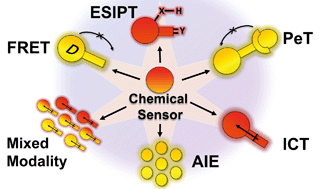
Chem. Sci., 2021,12, 3406-3426
https://doi.org/10.1039/D0SC06928K
New directions of activity-based sensing for in vivo NIR imaging
In vivo imaging is a powerful approach to study biological processes.
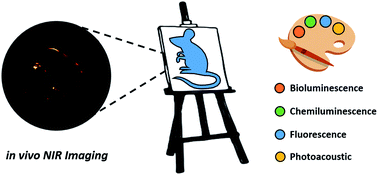
Chem. Sci., 2021,12, 3393-3405
https://doi.org/10.1039/D0SC03096A
Near-infrared fluorescent molecular probes for imaging and diagnosis of nephro-urological diseases
Near-infrared fluorescent molecular probes with improved imaging depth and optimized biodistribution have been reviewed, showing great potential for diagnosis of nephro-urological diseases.
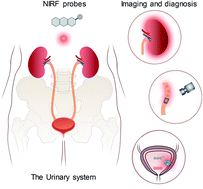
Chem. Sci., 2021,12, 3379-3392
https://doi.org/10.1039/D0SC02925D
Activatable fluorescence sensors for in vivo bio-detection in the second near-infrared window
Fluorescence imaging in the second near-infrared (NIR-II, 1000–1700 nm) window has exhibited advantages of high optical resolution at deeper penetration (ca. 5–20 mm) in bio-tissues owing to the reduced photon scattering and tissue autofluorescence.
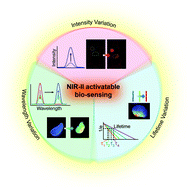
Chem. Sci., 2021,12, 3448-3459
https://doi.org/10.1039/D0SC04789A
Near-infrared fluorescent probes: a next-generation tool for protein-labeling applications
This minireview describes the development of NIR chemical probes for various protein-tag systems.
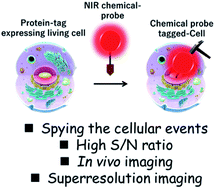
Chem. Sci., 2021,12, 3437-3447
https://doi.org/10.1039/D0SC04792A
Structural and process controls of AIEgens for NIR-II theranostics
Structural and process controls of NIR-II AIEgens realize manipulating of radiative (R) and nonradiative (NR) decay for precise theranostics.
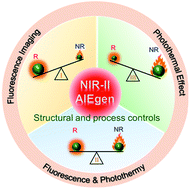
Chem. Sci., 2021,12, 3427-3436
https://doi.org/10.1039/D0SC02911D
A facile way to obtain near-infrared room-temperature phosphorescent soft materials based on Bodipy dyes
Near-infrared room-temperature phosphorescence was achieved by employing iodine substituted Bodipy into amorphous polymers. The self-healable gels were also obtained with the incorporation of a crosslinker and quadruple hydrogen bond based moieties.

Chem. Sci., 2020,11, 482-487
https://doi.org/10.1039/C9SC05502A
An aggregation-induced emission dye-powered afterglow luminogen for tumor imaging
An aggregation-induced emission (AIE) dye-powered afterglow luminogen has been designed for in vivo tumor imaging. The underlying afterglow mechanism can be described as a closed-loop of “photon–1O2–SP intermediates–photon”.
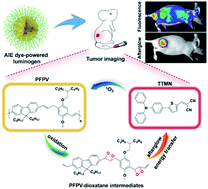
Chem. Sci., 2020,11, 419-428
https://doi.org/10.1039/C9SC04901K
Far-red/near-infrared emitting, two-photon absorbing, and bio-stable amino-Si-pyronin dyes
Far-red/NIR emitting, two-photon absorbing, biostable aminosilapyronin dyes (ASiPj) and their derivatives (NIR-ASiPj) offer novel (ratiometric) bioimaging platforms.
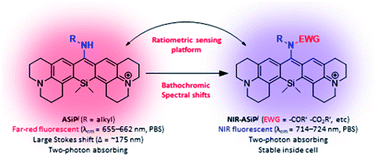
Chem. Sci., 2019,10, 9028-9037
https://doi.org/10.1039/C9SC02287B
Near-infrared fluorescein dyes containing a tricoordinate boron atom
Tricoordinate boron imparts near-infrared absorption/emission and unusual multi-stage changes in the photophysical properties to fluorescein dyes.
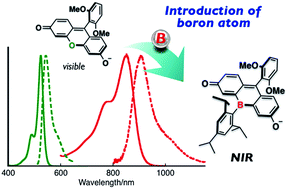
Chem. Sci., 2019,10, 7816-7821
https://doi.org/10.1039/C9SC02314C
A molecular design strategy toward enzyme-activated probes with near-infrared I and II fluorescence for targeted cancer imaging
A molecular design strategy is established to access diverse enzyme-activated probes that are excitable and emit in the NIR (I and II) region with favorable Stokes shifts, enabling targeted cancer imaging by real-time monitoring enzyme activities.
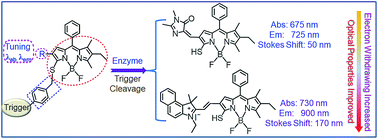
Chem. Sci., 2019,10, 7222-7227
https://doi.org/10.1039/C9SC02093D
A nano-cocktail of an NIR-II emissive fluorophore and organoplatinum(II) metallacycle for efficient cancer imaging and therapy
A novel NIR-II theranostic nanoprobe, PSY (∼110 nm), was concisely developed, which demonstrated excellent photostability, high tumor uptake, superior S/N ratios and more efficient cancer treatment with minimal side effects than cisplatin.
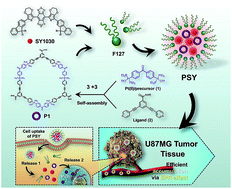
Chem. Sci., 2019,10, 7023-7028
https://doi.org/10.1039/C9SC02466B
Light emission enhancement by supramolecular complexation of chemiluminescence probes designed for bioimaging
Chemiluminescence offers advantages over fluorescence for bioimaging, since an external light source is unnecessary with chemiluminescent agents.
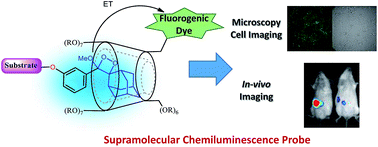
Chem. Sci., 2019,10, 2945-2955
https://doi.org/10.1039/C8SC05174G
In situ imaging of aminopeptidase N activity in hepatocellular carcinoma: a migration model for tumour using an activatable two-photon NIR fluorescent probe
In this work, a novel NIR two-photon fluorescence probe DCM-APN is reported for tracking APN in vitro and in vivo.

Chem. Sci., 2019,10, 1619-1625
https://doi.org/10.1039/C8SC04685A
Chemiluminescence-initiated and in situ-enhanced photoisomerization for tissue-depth-independent photo-controlled drug release
Tissue-penetration-depth-independent self-luminescence is highly expected to perform photoisomerization-related bioapplications in vivo to overcome the limitation of shallow tissue-penetration from external photoexcitation.
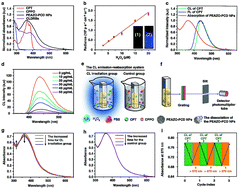
Chem. Sci., 2019,10, 1401-1409
https://doi.org/10.1039/C8SC04012E
Novel near-infrared II aggregation-induced emission dots for in vivo bioimaging
Novel biocompatible NIR-II aggregation-induced emission dots are facilely assembled and used for NIR-II biomedical fluorescence imaging.
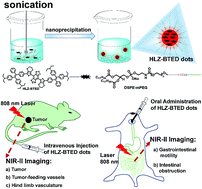
Chem. Sci., 2019,10, 1219-1226
https://doi.org/10.1039/C8SC04363A
Molecular design of near-infrared fluorescent Pdots for tumor targeting: aggregation-induced emission versus anti-aggregation-caused quenching
This article presents the first work to fundamentally study the effect of steric hindrance in Pdot systems.
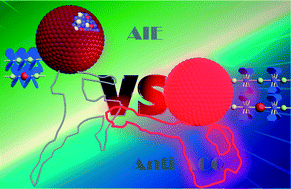
Chem. Sci., 2019,10, 198-207
https://doi.org/10.1039/C8SC03510E
Covalent organic nanosheets for bioimaging
Non-toxic covalent organic nanosheet-based fluorescent nuclear stains.
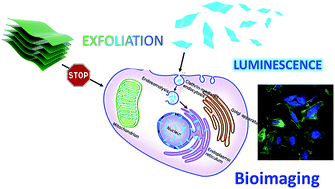
Chem. Sci., 2018,9, 8382-8387
https://doi.org/10.1039/C8SC02842G
ZrMOF nanoparticles as quenchers to conjugate DNA aptamers for target-induced bioimaging and photodynamic therapy
Aptamer conjugated porphyrinic metal–organic framework (MOF) achieved target-induced bioimaging and photodynamic therapy.
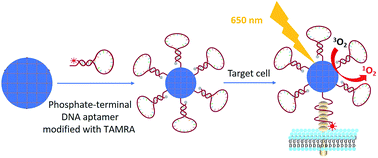
Chem. Sci., 2018,9, 7505-7509
https://doi.org/10.1039/C8SC02210K
Tricarbocyanine N-triazoles: the scaffold-of-choice for long-term near-infrared imaging of immune cells in vivo
Tricarbocyanine N-triazoles are first described as rationally-designed structures to overcome the limitations of NIR dyes for long-term in vivo imaging.
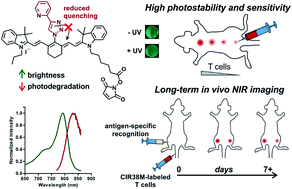
Chem. Sci., 2018,9, 7261-7270
https://doi.org/10.1039/C8SC00900G
Near-infrared fluorescence probes to detect reactive oxygen species for keloid diagnosis
Development of molecular probes for the detection of reactive oxygen and nitrogen species (RONS) is important for the pathology and diagnosis of keloid diseases.
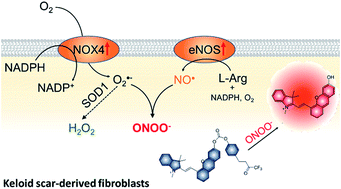
Chem. Sci., 2018,9, 6340-6347
https://doi.org/10.1039/C8SC01865K
Detection of analytes in mitochondria without interference from other sites based on an innovative ratiometric fluorophore
A new strategy that integrates the targeting group and response moiety together for the preparation of mitochondrial probe was developed. Bioimaging studies have shown that for the first time, the newly designed probe HDFL-Cys can first accumulate in mitochondria and then react with the analyte.
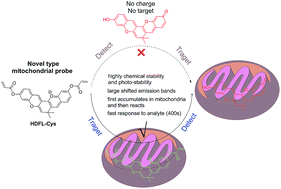
Chem. Sci., 2018,9, 5461-5466
https://doi.org/10.1039/C8SC01673A
Intense near-infrared-II luminescence from NaCeF4:Er/Yb nanoprobes for in vitro bioassay and in vivo bioimaging
We report the controlled synthesis of monodisperse NaCeF4:Er/Yb nanoprobes that exhibit intense NIR-II emission for in vitro bioassay and in vivo bioimaging.
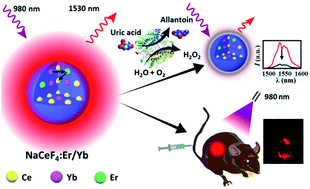
Chem. Sci., 2018,9, 4682-4688
https://doi.org/10.1039/C8SC00927A
Highly luminescent, biocompatible ytterbium(III) complexes as near-infrared fluorophores for living cell imaging
We report three synthetic methods to prepare biocompatible Yb3+ complexes, which displayed high NIR luminescence with quantum yields up to 13% in aqueous media. This renders β-fluorinated Yb3+ porphyrinoids a new class of NIR probes for living cell imaging including time-resolved fluorescence lifetime imaging.
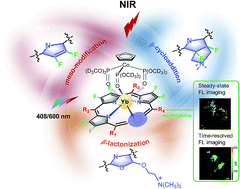
Chem. Sci., 2018,9, 3742-3753
https://doi.org/10.1039/C8SC00259B
Design, synthesis, and time-gated cell imaging of carbon-bridged triangulenium dyes with long fluorescence lifetime and red emission
Introduction of an isopropyl bridge in the triangulenium skeleton leads to a new series of redshifted triangulenium dyes with high fluorescence quantum yields and remarkable long fluorescence lifetime allowing for time-gated cell imaging.
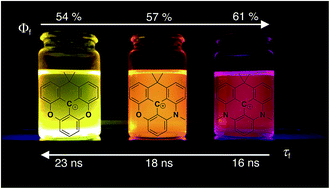
Chem. Sci., 2018,9, 3122-3130
https://doi.org/10.1039/C8SC00089A
Bioresponsive and near infrared photon co-enhanced cancer theranostic based on upconversion nanocapsules
A yolk-like nanocapsule with responsiveness to tumor microenvironment and NIR photons was invented by integrating a tumor-responsive photothermal agent on Mn-doped UCNPs@mSiO2 nanospheres for multiple imaging guided thermo-chemotherapy.
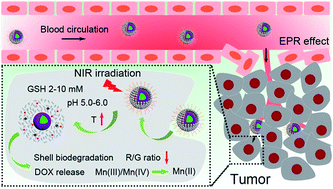
Chem. Sci., 2018,9, 3233-3247
https://doi.org/10.1039/C7SC05414A
Diketopyrrolopyrrole-based semiconducting polymer nanoparticles for in vivo second near-infrared window imaging and image-guided tumor surgery
PDFT1032, a new semiconducting polymer possessing a favorable absorption peak (1032 nm) and outstanding biocompatibility, may be widely applicable in clinical imaging and the surgical treatment of malignancy.
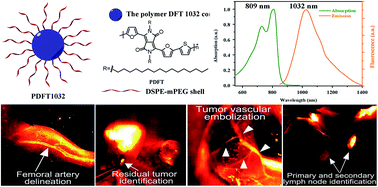
Chem. Sci., 2018,9, 3105-3110
https://doi.org/10.1039/C8SC00206A
Ultrabright red AIEgens for two-photon vascular imaging with high resolution and deep penetration
A successful strategy for the design of ultrabright red luminogens with aggregation-induced emission (AIE) features is reported. The AIE dots can be utilized as efficient fluorescent probes for in vivo deep-tissue imaging with high penetration depth and high contrast.
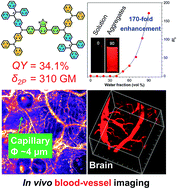
Chem. Sci., 2018,9, 2705-2710
https://doi.org/10.1039/C7SC04820C
About this collection
Near-infrared (NIR) fluorescence imaging (wavelength range: 650–1700 nm) is one of the remarkable imaging modalities for improved bioimaging and biosensing in both fundamental research and clinical applications, owing to its high spatiotemporal resolution and noninvasiveness. It has been a growing research topic for decades and will continue to flourish in the coming years. In this themed issue, selected studies focused on NIR bioimaging and biosensing published in Chemical Science in the past 18 months have been collected. Through this themed issue, we aim to call on the research community to strengthen cooperation with scientists among diverse research fields, such as chemistry, biology and biomedicine.